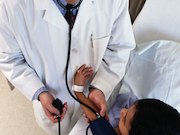Increase in estimated population prevalence of elevated blood pressure from 11.8 to 14.2 percent
WEDNESDAY, April 25, 2018 (HealthDay News) — The prevalence and severity of high blood pressure (BP) in children have increased based on the 2017 American Academy of Pediatrics clinical practice guidelines, according to a study published online April 23 in JAMA Pediatrics.
Atul K. Sharma, M.D., from the University of Manitoba in Winnipeg, Canada, and colleagues examined the consequences of the American Academy of Pediatrics clinical practice guidelines for the management of elevated BP in children. Guidelines from 2004 and 2017 were applied to classify BP in 15,647 generally healthy, low-risk children aged 5 to 18 years. Children whose BP was reclassified upward (cases) were matched by sex, age, and height with controls with normal BP.
The researchers found that the estimated (weighted) population prevalence of elevated BP increased from 11.8 to 14.2 percent. Overall, 5.8 percent of children had newly diagnosed hypertension or a worsening in clinical stage, representing a substantial increase in disease burden for the health care system. The likelihood of being overweight or obese, with higher z scores for weight, waist circumference, and body mass index, was increased for children whose BP was reclassified upward. There was also an increase in the prevalence of abnormal laboratory test results, with adverse lipid profiles and increased hemoglobin A1c levels.
“Clustering of cardiovascular risk factors in otherwise healthy U.S. children suggests that those whose BP was reclassified represent a high-risk population whose cardiovascular risk may previously have been underestimated,” the authors write.
Abstract/Full Text
Editorial (subscription or payment may be required)
Copyright © 2018 HealthDay. All rights reserved.








